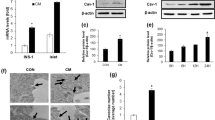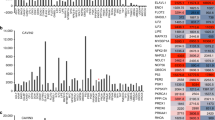Abstract
Caveolin-1 is a protein component (of relative molecular mass 22,000) of the striated coat that decorates the cytoplasmic surface of caveolae membranes. Previous biochemical and molecular tests have indicated that caveolin-1 is an integral membrane protein that is co-translationally inserted into endoplasmic-reticulum membranes of fibroblast and epithelial cells such that its carboxy- and amino-terminal ends are in the cytoplasm. Here we identify caveolin-1 in the secretory pathway of exocrine cells. Secretion of caveolin-1 from pancreatic acinar cells and a transfected exocrine cell line, but not from Chinese hamster ovary cells, is stimulated by the secretagogues secretin, cholecystokinin and dexamethasone. The secreted caveolin-1 co-fractionates with apolipoproteins, indicating that it may be secreted in a complex with lipids.
This is a preview of subscription content, access via your institution
Access options
Subscribe to this journal
Receive 12 print issues and online access
$209.00 per year
only $17.42 per issue
Buy this article
- Purchase on Springer Link
- Instant access to full article PDF
Prices may be subject to local taxes which are calculated during checkout







Similar content being viewed by others
References
Rothberg, K. G. et al. Caveolin, a protein component of caveolae membrane coats. Cell 68, 673–682 ( 1992).
Peters, K.-R., Carley, W. W. & Palade, G. E. Endothelial plasmalemmal vesicles have a characteristic striped bipolar surface structure. J. Cell Biol. 101 , 2233–2238 (1985).
Engelman, J. A. et al. Molecular genetics of the caveolin gene family: implications for human cancers, diabetes, Alzheimer disease, and muscular dystrophy. Am. J. Hum. Genet. 63, 1578–1587 (1998).
Monier, S. et al. VIP21-caveolin, a membrane protein constituent of the caveolar coat, oligomerizes in vivo and in vitro. Mol. Biol. Cell 6, 911–927 ( 1995).
Monier, S., Dietzen, D. J., Hastings, W. R., Lublin, D. M. & Kurzchalia, T. V. Oligomerization of VIP21-caveolin in vitro is stabilized by long chain fatty acylation or cholesterol. FEBS Lett. 388, 143–149 (1996).
Sargiacomo, M. et al. Oligomeric structure of caveolin: implications for caveolae membrane organization. Proc. Natl Acad. Sci. USA 92 , 9407–9411 (1995).
Fra, A. M., Williamson, E., Simons, K. & Parton, R. G. De novo formation of caveolae in lymphocytes by expression of VIP21-caveolin . Proc. Natl Acad. Sci. USA 92, 8655– 8659 (1995).
Li, S., Song, K. S., Koh, S. S., Kikuchi, A. & Lisanti, M. P. Baculovirus-based expression of mammalian caveolin in Sf21 insect cells. A model system for the biochemical and morphological study of caveolae biogenesis. J. Biol. Chem. 271, 28647–28654 (1996).
Glenney, J. R. The sequence of human caveolin reveals identity with VIP21, a component of transport vesicles. FEBS Lett. 314, 45– 48 (1992).
Dietzen, D. J., Hastings, W. R. & Lublin, D. M. Caveolin is palmitoylated on multiple cysteine residues. Palmitoylation is not necessary for localization of caveolin to caveolae. J. Biol. Chem. 270, 6838–6842 (1995).
Dupree, P., Parton, R. G., Raposo, G., Kurzchalia, T. V. & Simons, K. Caveolae and sorting in the trans-Golgi network of epithelial cells. EMBO J. 12, 1597–1605 (1993).
Song, S. K. et al. Co-purification and direct interaction of Ras with caveolin, an integral membrane protein of caveolae microdomains. Detergent-free purification of caveolae microdomains. J. Biol. Chem. 271, 9690–9697 (1996).
Kurzchalia, T. V. et al. VIP21, a 21-kD membrane protein is an integral component of trans-Golgi-network-derived transport vesicles. J. Cell Biol. 118, 1003–1014 (1992).
Anderson, R. G. W. The caveolae membrane system. Annu. Rev. Biochem. 67 , 199–225 (1998).
Chang, W.-J., Rothberg, K. G., Kamen, B. A. & Anderson, R. G. W. Lowering the cholesterol content of MA104 cells inhibits receptor mediated transport of folate. J. Cell Biol. 118, 63–69 (1992).
Murata, M. et al. Identification of caveolin-1 as a fatty acid binding protein . Proc. Natl Acad. Sci. USA 92, 10339– 10343 (1995).
Trigatti, B., Anderson, R. G. W. & Gerber, G. A role for caveolin in transport of cholesterol from ER to plasma membrane. Biochem. Biophys. Res. Commun. 255, 34–39 (1999).
Smart, E. J., Ying, Y.-S., Donzell, W. C. & Anderson, R. G. W. A role for caveolin in transport of cholesterol from ER to plasma membrane . J. Biol. Chem. 271, 29427– 29435 (1996).
Smart, E. J., Ying, Y.-U., Conrad, P. A. & Anderson, R. G. W. Caveolin moves from caveolae to the Golgi apparatus in response to cholesterol oxidation. J. Cell Biol. 127, 1185– 1197 (1994).
Conrad, P. A., Smart, E. J., Ying, Y.-S., Anderson, R. G. W. & Bloom, G. S. Caveolin cycles between plasma membrane caveolae and the Golgi complex by microtubule-dependent and microtubule-independent steps. J. Cell Biol. 131, 1424– 1433 (1995).
Ridgway, N. D., Dawson, P. A., Ho, Y. K., Brown, M. S. & Goldstein, J. L. Translocation of oxysterol binding protein to Golgi apparatus triggered by ligand binding. J. Cell Biol. 116, 307–319 (1992).
Christophe, J. Pancreatic tumoral cell line AR42J: an amphicrine model. Am. J. Physiol. 266, G963–G971 (1994).
Engelman, J. A. et al. Recombinant expression of caveolin-1 in oncogenically transformed cells abrogates anchorage-independent growth. J. Biol. Chem. 272, 16374–16381 (1997).
Blobel, G. & Dobberstein, B. Transfer of proteins across membranes. I. Presence of proteolytically processed and unprocessed nascent immunoglobulin light chains on membrane-bound ribosomes of murine myeloma . J. Cell Biol. 67, 835– 851 (1975).
Matlack, K. E., Mothes, W. & Rapoport, T. A. Protein translocation: tunnel vision. Cell 92, 381–390 ( 1998).
Uittenbogaard, A., Ying, Y. & Smart, E. J. Characterization of a cytosolic heat-shock protein-caveolin chaperone complex. Involvement in cholesterol trafficking. J. Biol. Chem. 273, 6525–6532 ( 1998).
Trigatti, B. L., Mangroo, D. & Gerber, G. E. Photoaffinity labeling and fatty acid permeation in 3T3-L1 adipocytes. J. Biol. Chem. 266, 22621–22625 (1991).
Fielding, C. J., Bist, A. & Fielding, P. E. Caveolin mRNA levels are up-regulated by free cholesterol and down-regulated by oxysterols in fibroblast monolayers. Proc. Natl Acad. Sci. USA 94, 3753–3758 (1997).
Hailstones, D., Sleer, L. S., Parton, R. G. & Stanley, K. K. Regulation of caveolin and caveolae by cholesterol in MDCK cells. J. Lipid. Res. 39, 369–379 (1998).
Okamoto, T., Schlegel, A., Scherer, P. E. & Lisanti, M. P. Caveolins, a family of scaffolding proteins for organizing ‘‘preassembled signaling complexes’’ at the plasma membrane. J. Biol. Chem. 273, 5419–5422 ( 1998).
Ko, Y. G., Liu, P., Pathak, R. K., Craig, L. C. & Anderson, R. G. Early effects of pp60(v-src) kinase activation on caveolae. J. Cell. Biochem. 71, 524– 535 (1998).
Kongshaug, M., Moan, J. & Brown, S. B. The distribution of porphyrins with different tumour localising ability among human plasma proteins. Br. J. Cancer 59, 184–188 (1989).
Roth, J. Postembedding labeling on Lowicryl K4M tissue sections: detection and modification of cellular components. Methods Cell Biol. 31, 513–551 (1989).
Tokuyasu, K. T. Immunochemistry on ultrathin frozen sections. Histochem. J. 12, 381–403 (1980).
Acknowledgements
We thank M. Zhu for valuable technical assistance; S. Knight for administrative assistance; D. Spady for his assistance with the ApoA1-deficient mice; and M. Brown and J. Goldstein for helpful suggestions during the preparation of the manuscript. This work was supported by grants from the NIH (HL20948 and GM52016) and by the Perot Family Foundation. T.M. was supported by a postdoctoral fellowship from the Deutsche Forschungsgemeinschaft.
Correspondence and requests for materials should be addressed to R.G.W.A.
Author information
Authors and Affiliations
Corresponding author
Rights and permissions
About this article
Cite this article
Liu, P., Li, WP., Machleidt, T. et al. Identification of caveolin-1 in lipoprotein particles secreted by exocrine cells. Nat Cell Biol 1, 369–375 (1999). https://doi.org/10.1038/14067
Received:
Revised:
Accepted:
Published:
Issue Date:
DOI: https://doi.org/10.1038/14067
This article is cited by
-
Caveola-forming proteins and prostate cancer
Cancer and Metastasis Reviews (2020)
-
Caveolin-1 function at the plasma membrane and in intracellular compartments in cancer
Cancer and Metastasis Reviews (2020)
-
Caveolin-1 Promotes the Imbalance of Th17/Treg in Patients with Chronic Obstructive Pulmonary Disease
Inflammation (2016)
-
Caveolin-1 in oral squamous cell carcinoma microenvironment: an overview
Tumor Biology (2014)
-
Caveola-forming proteins caveolin-1 and PTRF in prostate cancer
Nature Reviews Urology (2013)



